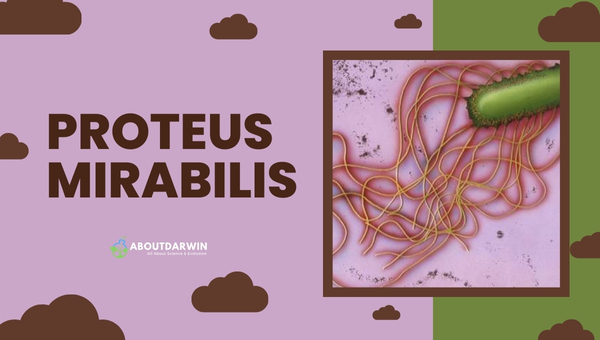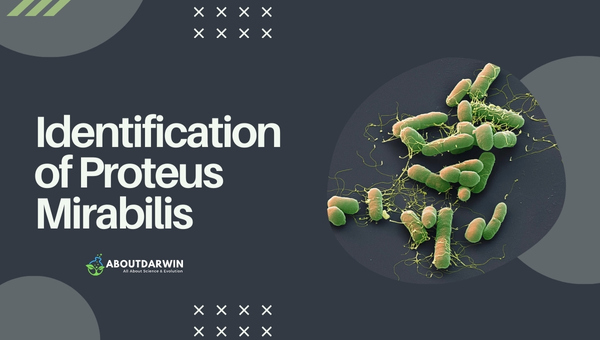Physical Address
304 North Cardinal St.
Dorchester Center, MA 02124
Proteus mirabilis is a remarkable bacterium that plays a dual role in our ecosystem, often residing harmlessly in the human gut while also posing significant health risks when it invades other areas, such as the urinary tract.
This rod-shaped, Gram-negative organism is known for its unique swarming behavior on agar plates, a feature that sets it apart from many other bacteria.
As we explore the fascinating world of Proteus mirabilis, its biochemical properties and identification methods reveal insights critical for managing potential infections. The microscopic universe is full of surprises, and understanding this bacterium is just the beginning.
Contents
Proteus mirabilis is a significant bacterium within the Enterobacteriaceae family, primarily known for its role in urinary tract infections (UTIs) and its unique biological characteristics.

This rod-shaped, Gram-negative organism exhibits facultative anaerobic properties and is notable for its rapid swarming motility and urease production.
P. mirabilis is crucial not only for clinical microbiology but also for addressing the challenges it poses in medical settings, particularly concerning antibiotic resistance.
Proteus mirabilis is a significant pathogen known for its role in urinary tract infections (UTIs) and other opportunistic infections. As a gram-negative bacterium, it is part of the normal flora of the human gastrointestinal tract but can become pathogenic under certain conditions.
The causes of Proteus mirabilis infections is crucial for effective prevention and treatment strategies, especially in vulnerable populations such as those with indwelling catheters or compromised immune systems.
Opportunistic Nature: Proteus mirabilis infections are primarily opportunistic, often occurring in individuals with compromised immunity, such as those with diabetes or chronic illnesses.
The bacterium is commonly associated with long-term catheterization, where it can ascend from the gastrointestinal tract to the urinary tract, leading to catheter-associated urinary tract infections (CAUTIs).
Risk Factors: Several factors increase the risk of infection by P. mirabilis:
Virulence Factors: P. mirabilis possesses several virulence factors that enhance its pathogenicity:
Proteus mirabilis infections are primarily caused by its opportunistic nature, specific risk factors associated with host conditions, and various virulence mechanisms that enable it to thrive in unfavorable environments.
Proteus mirabilis is a gram-negative bacterium commonly associated with urinary tract infections (UTIs) and other infections, particularly in patients with compromised immunity or those using long-term catheters.
The symptoms associated with infections caused by this organism is crucial for timely diagnosis and treatment.
The symptoms can vary based on the infection site, and early recognition can help prevent complications such as kidney damage or systemic infections.
Urinary Tract Infections (UTIs):
Wound Infections:
Septicemia:
Pyelonephritis (Kidney Infection):
Recognizing these symptoms is vital for effective treatment, which typically involves antibiotics tailored to the specific strain of Proteus mirabilis identified through culture tests.
Proteus mirabilis is a significant pathogen in clinical microbiology, particularly known for causing urinary tract infections (UTIs).
The identification of P. mirabilis relies heavily on various biochemical tests that yield specific results, aiding in accurate diagnosis and treatment.
The following sections outline the biochemical tests for Proteus mirabilis, their results, and their clinical implications.
The biochemical test results for Proteus mirabilis are crucial for its identification. These tests include:
| Test | Result |
|---|---|
| Gram Staining | Negative (-ve) |
| Urease | Positive (+ve) |
| H2S Production | Positive (+ve) |
| Indole | Negative (-ve) |
| Methyl Red | Positive (+ve) |
| Citrate Utilization | Positive (+ve) |
| Catalase | Positive (+ve) |
| Oxidase | Negative (-ve) |
| Motility | Positive (+ve) |
These proteus mirabilis biochemical test results demonstrate its urease production, which is a key factor in its pathogenicity, particularly in alkaline urine environments that promote struvite stone formation.
The ability to produce hydrogen sulfide (H2S) is another distinguishing feature that aids in differentiating it from other Enterobacteriaceae species.
The biochemical tests for Proteus mirabilis not only confirm its presence but also provide insights into its metabolic capabilities.
For instance, the positive urease test indicates that the organism can hydrolyze urea, leading to an increase in urine pH, which is significant in the context of UTIs and renal stone formation.
Additionally, the negative lactose fermentation result helps distinguish P. mirabilis from lactose-fermenting bacteria like Escherichia coli.
The proteus mirabilis test results is essential for clinicians when diagnosing infections. A positive culture alongside specific biochemical test results can confirm an active infection and guide appropriate antibiotic therapy.
Furthermore, recognizing the organism’s characteristics can help predict complications such as struvite stones, which necessitate a more comprehensive management approach.
The biochemical testing of Proteus mirabilis plays a vital role in clinical microbiology by providing essential information for diagnosis and treatment strategies.
The oxidase test is a biochemical assay used to determine the presence of cytochrome c oxidase in bacteria. This enzyme is part of the electron transport chain and is crucial for aerobic respiration.
In the context of Proteus mirabilis, this test helps differentiate it from other gram-negative bacteria, particularly those within the Enterobacteriaceae family.
The oxidase test is particularly useful in clinical microbiology for identifying P. mirabilis in urine cultures from patients suspected of having UTIs.
Given that P. mirabilis can produce urease and form struvite stones, its identification through this test aids in appropriate diagnosis and treatment strategies for urinary tract infections.
The oxidase test serves as an essential tool in microbiological diagnostics, helping to distinguish Proteus mirabilis from other similar pathogens and contributing to effective patient management in clinical settings.
The indole test is designed to evaluate whether an organism can convert tryptophan into indole through the action of tryptophanase, an enzyme produced by certain bacteria.
A positive result indicates the presence of indole, which can be detected using specific reagents that change color upon reaction with indole.
Sample Preparation: A pure culture of the bacterial isolate is grown in a medium rich in tryptophan for 24-48 hours.
Testing Methods:
While the indole test is effective, it may yield false positives or negatives if not performed under controlled conditions. It is recommended to use this test alongside other biochemical tests for accurate identification of bacterial strains.
The indole test remains a fundamental tool in microbiology for identifying Proteus mirabilis and differentiating it from closely related species. Its simplicity and effectiveness make it a staple in clinical laboratories for diagnosing bacterial infections.
Proteus vulgaris is a significant bacterium in clinical microbiology, often associated with urinary tract infections and other opportunistic infections.
Accurate identification of this organism relies heavily on a series of biochemical tests, which reveal its metabolic capabilities and help differentiate it from other species.
The following outlines the biochemical test results for Proteus vulgaris, highlighting its unique characteristics.
1. Indole Test
2. Methyl Red Test
3. Urease Test
4. Motility Test
5. Hydrogen Sulfide Production Test
7. Carbohydrate Fermentation Tests
These biochemical tests are essential for accurately identifying Proteus vulgaris and understanding its role in human infections.
By interpreting the proteus biochemical test results, healthcare professionals can make informed decisions regarding treatment and management of infections caused by this organism.
Proteus vulgaris is a significant bacterium in microbiology, known for its role as an opportunistic pathogen and its unique biochemical characteristics.
This rod-shaped, Gram-negative organism is particularly notable for its ability to reduce nitrate, produce hydrogen sulfide, and ferment certain carbohydrates.
The citrate test is one of the key biochemical tests used to identify P. vulgaris, as it helps determine the bacterium’s ability to utilize citrate as a carbon source.
Overview of the Citrate Test: The citrate test assesses the ability of Proteus vulgaris to utilize citrate as its sole carbon source. This is crucial for distinguishing P. vulgaris from other bacteria in clinical microbiology.
Test Procedure:
Interpretation of Results:
Clinical Significance: The citrate test is part of a series of biochemical tests used for the identification of Proteus vulgaris. While some strains may test positive for citrate utilization, others may not, indicating variability in metabolic capabilities among different isolates.
These characteristics aids in diagnosing infections caused by this bacterium, which is often associated with urinary tract infections and other opportunistic infections.
The citrate test is a valuable tool in microbiological diagnostics, providing insight into the metabolic functions of Proteus vulgaris and aiding in its identification among other enteric pathogens.
Proteus mirabilis is a Gram-negative, facultatively anaerobic, rod-shaped bacterium belonging to the Enterobacteriaceae family.

It is widely recognized as an opportunistic pathogen, primarily associated with urinary tract infections (UTIs) and catheter-associated urinary tract infections (CAUTIs).
This bacterium exhibits distinctive characteristics such as swarming motility and urease production, which play significant roles in its pathogenicity.
Proteus mirabilis is primarily implicated in urinary tract infections, especially in individuals with long-term indwelling catheters or those suffering from complicated UTIs. It accounts for approximately 90% of all Proteus infections in humans.
The bacterium’s ability to form biofilms on catheters and other medical devices contributes to its virulence and resistance to host defenses.
Infections caused by P. mirabilis can lead to various clinical manifestations including dysuria, turbid urine, abdominal discomfort, fever, and chills.
The emergence of antibiotic-resistant strains poses significant treatment challenges, particularly with the rise of extended-spectrum beta-lactamases (ESBLs) and carbapenem-resistant variants.
Also Read: Streptococcus Pneumoniae: Identification & Biochemical Tests
The microbial world, it quickly becomes evident that prevention is definitely better than cure. Keeping Proteus mirabilis at bay, then, starts with some essential hygiene practices.
Regular hand washing, clean water, and basic sanitary measures can dramatically reduce the risk of any kind of infection, including those caused by this opportunistic bacterium.
Early detection is another critical component when it comes to control. The faster we identify an infection or a bacterial presence where it shouldn’t be, the quicker and more effectively we can take steps to tackle it.
Techniques like biochemical tests for Proteus mirabilis are crucial in such instances as they provide us with the necessary information on which antibiotics would be most effective against a given strain of bacteria.
Also Read: Arteries and Veins: Understanding Differences and Impacts on Health
Proteus mirabilis is a gram-negative bacterium that is primarily known for causing urinary tract infections (UTIs), particularly in individuals with long-term catheterization.
This bacterium is part of the normal flora in the human gastrointestinal tract but can become pathogenic under certain conditions.
Preventing the transmission of Proteus mirabilis involves a combination of hygiene practices, careful management of medical devices, and awareness of its transmission routes.
Here are key strategies to avoid transmission:
The hydrolysis of urea forms the weak base, ammonia, as one of its products. This weak base raises the pH of the media above 8.4, and the pH indicator, phenol red, turns from yellow to pink.
Vulgaris is tested using the API 20E identification system it produces positive results for sulfur reduction, urease production, tryptophan deaminase production, indole production, sometimes positive gelatinase activity, and saccharose fermentation, and negative results for the remainder of the tests on the testing.
Proteus mirabilis is a Gram-negative, rod-shaped, motile bacterium that produces high levels of urease, a protein that hydrolyzes urea to ammonia. P. mirabilis can be detected in the lab by its unique characteristic of swarming when grown on agar plates. Additionally, this bacterium gives off a strong fishy odor.
Biochemical tests are used to identify bacterial species by differentiating them on the basis of biochemical activities.
Proteus vulgaris does not ferment lactose, but it can ferment glucose and sucrose, producing hydrogen sulfide in the process.
Proteus mirabilis plays a significant role in both clinical and environmental microbiology. Recognized for its ability to cause urinary tract infections and its unique swarming motility, this bacterium is a subject of ongoing research.
Its adaptability and resistance to antibiotics pose challenges in treatment, highlighting the need for effective management strategies. Its mechanisms can lead to better therapeutic approaches and improved patient outcomes.
Continued investigation into Proteus mirabilis will enhance our knowledge of infectious diseases and contribute to advancements in microbiological science.